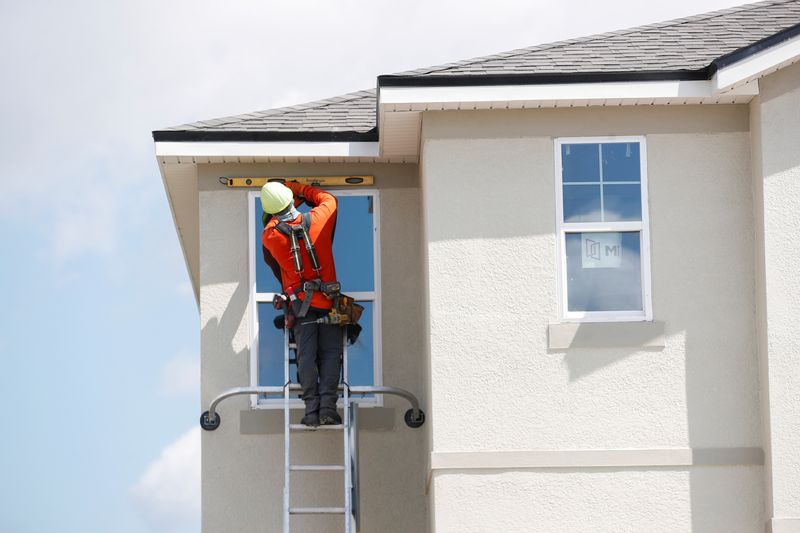Mortgage Rates Plummet to Lowest Level in Over a Year
A welcome development for the housing market, mortgage rates have fallen to their lowest level in over a year.
The average rate on the 30-year fixed-rate mortgage has dropped to 6.47%, marking a significant decline from 6.73% just last week.
Experts Attribute the Decline to Upcoming Interest Rate Cut

According to experts, the decline in mortgage rates is a result of the Federal Reserve’s expectation to cut interest rates in September.
“Mortgage rates plunged this week … following the likely overreaction to a less-than-favorable employment report and financial market turbulence for an economy that remains on solid footing,” said Sam Khater, Freddie Mac’s chief economist.
Falling Mortgage Rates Bolster Prospective Homebuyers

The decline in mortgage rates has increased prospective homebuyers’ purchasing power, making it easier for them to purchase a home.
“The decline in mortgage rates does increase prospective homebuyers’ purchasing power and should begin to pique their interest in making a move,” Khater added.
Slowdown in Housing Market Shows Signs of Favoring Buyers

While home prices have reached new highs, the rate of existing home sales has slowed, indicating a shift in the market dynamics.
“Supply and demand dynamics are nearing a balanced market condition,” said Lawrence Yun, NAR chief economist.
As the Market Slows Down, Buyers Are Getting Back in the Game
Despite the slight increase in mortgage applications, there are signs that prospective buyers are starting to get back in the game.
Analysts at Goldman Sachs are predicting that home prices will rise 4.5% this year and 4.4% next, up from their previous forecast of 4.2% this year and 3.2% next year.
Average 30-Year Fixed-Rate Mortgage Rate Drops to 6.47%
The average rate on the 30-year fixed-rate mortgage has dropped to 6.47%, marking a significant decline from 6.73% just last week, according to Freddie Mac.
Rate Decline Largest in Over a Year

The rate decline is the largest in over a year, providing a welcome boost to the housing market, which has been grappling with affordability issues.
15-Year Fixed-Rate Mortgage Rate Also Sees Decline
In addition to the 30-year fixed-rate mortgage, the average rate for the 15-year fixed mortgage has also declined, dropping to 5.63% from 5.99% last week, Freddie Mac reported.
Historical Context Shows Rate is Still Relatively High

While the rate decline is a positive development for homebuyers, it’s worth noting that the 30-year fixed-rate mortgage rate is still relatively high compared to historical levels.
A year ago, the average rate on a 30-year fixed-rate loan was 6.96%, which means that today’s rate of 6.47% is still 49 basis points higher.
September Interest Rate Cut Expected to Push Rate Lower
Experts predict that the Federal Reserve’s upcoming interest rate cut in September will push mortgage rates even lower, making it even easier for homebuyers to secure financing.
“We expect that mortgage rates will continue to drift lower through the remainder of the year, particularly if the Fed does launch a series of rate cuts in September,” said Mike Fratantoni, chief economist for the Mortgage Bankers Association.
Experts Predict Interest Rate Cut by Federal Reserve
Experts are predicting that the Federal Reserve will cut interest rates in September, which could push mortgage rates even lower.
Rate Cut Would be Fourth This Year

While the exact timing is uncertain, the rate cut would be the fourth this year, following previous cuts in May, June, and July.
The Fed has been monitoring inflation, employment, and economic growth, and has signaled that it will continue to take action to support the economy.
Solid Economic Fundamentals Fuel Rate Cut Expectations
The economy has been growing at a steady pace, with low unemployment and moderate inflation, which should help to support the Fed’s decision to cut rates.
According to Sam Khater, Freddie Mac’s chief economist, the Fed’s decision to cut rates is likely a result of the economy’s solid fundamentals.
“The economy remains on solid footing, despite some market volatility,” Khater said. “We expect the Fed to take a more accommodative stance with interest rates to support the economy.”
Rate Cut Could Persistence Well into 2025

Some experts predict that the rate cut could persist well into 2025, depending on the Fed’s assessment of the economy.
With the Fed’s actions, analysts at Goldman Sachs are predicting that home prices will rise 4.5% this year and 4.4% next, up from their previous forecast of 4.2% this year and 3.2% next year.
The continued support from the Fed’s interest rate policies could help to drive growth in the housing market and stimulate economic activity.
Falling Mortgage Rates Boost Prospective Homebuyers’ Purchasing Power
Falling mortgage rates have boosted prospective homebuyers’ purchasing power, making it easier for them to secure financing and purchase a home.
Purchasing Power Increased by Nearly 10%

A drop of just 26 basis points in the 30-year fixed-rate mortgage rate has increased purchasing power by nearly 10%.
This means that buyers who are approved for a $400,000 mortgage can now afford to borrow an additional $40,000.
More Buying Power for Homebuyers
The increased purchasing power is a welcome relief for homebuyers who have been facing affordability challenges in the current market.
According to Sam Khater, Freddie Mac’s chief economist, the decline in mortgage rates has “pierced the interest of prospective homebuyers” and is likely to lead to an increase in home purchases.
Improving Market Dynamics Expected
The decline in mortgage rates is expected to lead to improving market dynamics, with more buyers entering the market and prices potentially stabilizing.
“We expect the mortgage rate decline to be a positive catalyst for the housing market, as it increases the purchasing power of prospective homebuyers and provides a boost to the overall economy,” said Keith Gumbinger, vice president of HSH.com.
More Optimism for Homebuyers
With the decline in mortgage rates, there is more optimism for homebuyers who are looking to purchase a home in the coming months.
The increased purchasing power and improving market dynamics are expected to lead to a more stable and competitive housing market.
Slowdown in Housing Market Shows Signs of Favoring Buyers
The slowdown in the housing market is showing signs of favoring buyers, with a shift in market dynamics making it easier for prospective buyers to secure a home.
Signs of a Balanced Market
According to Lawrence Yun, NAR chief economist, the slowdown in the housing market is a sign that the market is moving towards a balanced condition, where the pace of price growth is slowing down.
This shift is being driven by a combination of factors, including a decline in mortgage rates and an increase in the supply of homes for sale.
Increased Inventory Helping to Ease Price Growth
The increase in inventory is helping to ease price growth, making it easier for buyers to find a home within their budget.
“With more homes available for sale, buyers have more negotiating power, and sellers are being forced to be more competitive in pricing their homes,” said Yun.
Buyers Getting Back in the Market
As the market shifts towards a more balanced condition, buyers are starting to get back in the market, with some even attracting multiple offers on their homes.
“We’re seeing a slow shift from a seller’s market to a buyer’s market,” said Yun. “This is a positive development for buyers, who will have more options and better prices to choose from.”
More Red Flags for Sellers
For sellers, the shift in market dynamics is a red flag, as it indicates that buyers have more power in the market and may be able to negotiate lower prices.
“Sellers should be prepared to be more competitive in pricing their homes, and buyers should take advantage of the increased negotiating power,” said Yun.
Mortgage Applications See Slight Increase Despite Ongoing Affordability Issues
Mortgage applications have seen a slight increase despite ongoing affordability issues in the housing market.
1% Increase in Mortgage Purchase Applications
According to data released by the Mortgage Bankers Association, mortgage purchase applications increased by 1% last week, despite a decline in mortgage rates.
This slight increase is a positive sign for the housing market, which has been struggling with affordability issues.
11% Decline in Mortgage Purchase Applications Year-over-Year
However, mortgage purchase applications are still 11% lower than they were last year at this time, indicating that affordability issues remain a challenge for homebuyers.
According to Joel Kan, vice president and deputy chief economist of the Mortgage Bankers Association, the decline in mortgage purchase applications is a result of ongoing affordability issues in the housing market.
Conventional Purchase Applications on the Rise
Despite the decline in mortgage purchase applications, conventional purchase applications are on the rise, suggesting that homebuyers are becoming more comfortable with the idea of purchasing a home despite affordability challenges.
“Conventional purchase applications are increasing, which is a positive sign for the housing market,” said Kan.
Government Purchase Applications Continue to Decline
Government purchase applications, on the other hand, continue to decline, indicating that buyers are still struggling to secure financing for their homes.
“Government purchase applications are decreasing, which is a concern for the housing market,” said Kan.
The mixed signals in the data suggest that the housing market is still navigating affordability issues, but there are signs of improvement.
Home Prices Reach New Highs Despite Slowing Sales
Home prices have reached new highs, despite slowing sales in the housing market.
Sales Slow Down, Prices Continue to Rise
According to data released by the National Association of Realtors, existing home sales slowed down in July, but home prices continued to rise.
On average, the median existing-home price increased by 5.7% compared to last year, reaching $389,500.
Slowest Sales Pace Since 2020
The slowdown in sales is the slowest pace since 2020, indicating that the housing market is experiencing a slowdown.
“The sale of existing homes slowed down in July, but the median home price continues to rise,” said Lawrence Yun, NAR chief economist.
However, the pace of price growth is easing, suggesting that the housing market may be stabilizing.
“The decline in sales is a sign that the market is stabilizing, and the ease in price growth is a welcome relief for buyers,” said Yun.
Positive Sign for the Market
The slowdown in sales and easing price growth are positive signs for the housing market, indicating that the market is returning to a more stable and sustainable growth path.
“This is a positive sign for the market, and we expect to see a continued slowdown in sales and easing price growth in the coming months,” said Yun.
Experts Weigh In on Impact of Falling Mortgage Rates
Experts are weighing in on the impact of falling mortgage rates on the housing market.
Increased Purchasing Power for Homebuyers
According to experts, falling mortgage rates are increasing purchasing power for homebuyers, making it easier for them to secure financing and purchase a home.
“Falling mortgage rates are a game-changer for homebuyers,” said Sam Khater, Freddie Mac’s chief economist. “It’s a welcome relief for buyers who have been facing affordability challenges.”
More Buying Power for Homebuyers
The decline in mortgage rates is providing more buying power for homebuyers, allowing them to afford more expensive homes.
“Buyers will have more negotiating power, and sellers will be forced to be more competitive in pricing their homes,” said Lawrence Yun, NAR chief economist.
Stabilization of the Housing Market
The fall in mortgage rates is also expected to lead to the stabilization of the housing market, with prices potentially stabilizing and sales increasing.
“The decline in mortgage rates will help to stabilize the housing market, and we expect to see a continued slowdown in sales and easing price growth in the coming months,” said Yun.
Lower Mortgage Rates aBooster for Economic Growth
Lower mortgage rates are also expected to be a booster for economic growth, as they make it easier for consumers to afford homes and stimulate spending.
“Lower mortgage rates will help to boost economic growth, as consumers will have more disposable income and be more likely to spend,” said Khater.
September Interest Rate Cut Expected to Push Mortgage Rates Lower
The Federal Reserve is expected to cut interest rates in September, which is expected to push mortgage rates even lower.
Fed’s Plan to Cut Interest Rates
The Fed has indicated that it plans to cut interest rates, which is expected to have a negative impact on the economy, but is seen as a necessary move to stimulate economic growth.
“The Fed is expected to cut interest rates in September, which will push mortgage rates lower and make it easier for homebuyers to secure financing,” said Sam Khater, Freddie Mac’s chief economist.
Mortgage Rates Expected to Fall Below 6%
Mortgage rates are expected to fall below 6% in the coming weeks, according to some experts, making it even easier for homebuyers to secure financing.
“We expect mortgage rates to fall below 6% by the end of the year, which will make it easier for homebuyers to afford homes,” said Lawrence Yun, NAR chief economist.
Booster for Economic Growth
The decline in mortgage rates is expected to be a booster for economic growth, as it will make it easier for consumers to afford homes and stimulate spending.
“Lower mortgage rates will help to boost economic growth, as consumers will have more disposable income and be more likely to spend,” said Khater.
Positive Impact on Housing Market
The decline in mortgage rates is also expected to have a positive impact on the housing market, with prices potentially stabilizing and sales increasing.
“The decline in mortgage rates will help to stabilize the housing market, and we expect to see a continued slowdown in sales and easing price growth in the coming months,” said Yun.



Add Comment